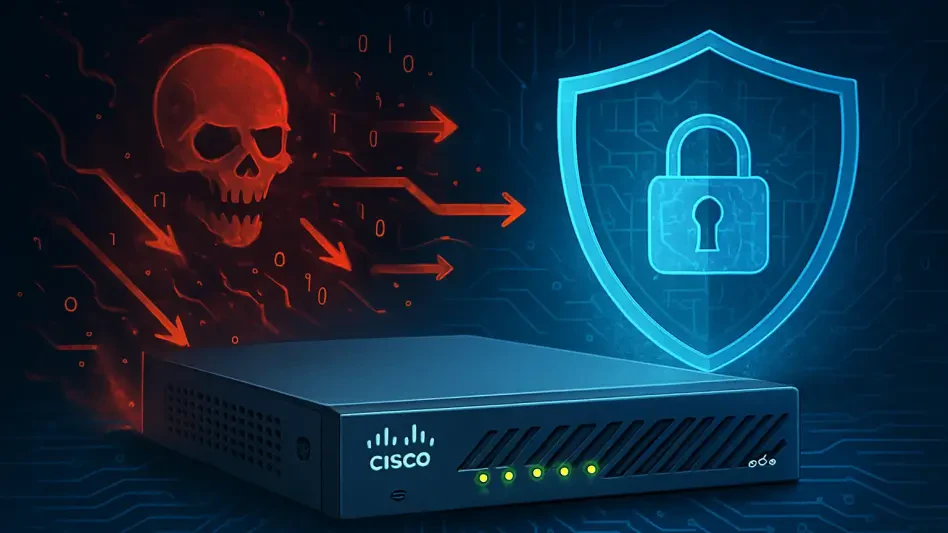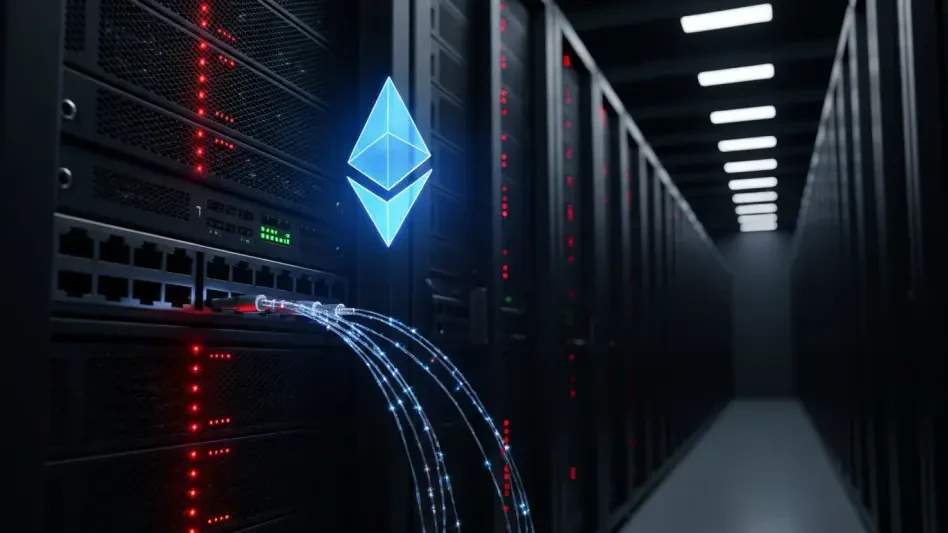Imagine a scenario where thousands of unseen adversaries are silently probing the digital defenses of critical network infrastructure across the globe, seeking a single weak point to exploit. This is the alarming reality facing Cisco Adaptive Security Appliance (ASA) devices, as recent data reveals a significant surge in scanning activity targeting these systems. Detected by cybersecurity monitoring platforms in late August, this wave of reconnaissance raises urgent questions about the security of devices that protect countless organizations.
The scale of this activity is staggering, with over 25,000 unique IP addresses focusing on the ASA web login path, a key access point for remote administration. Such a concentrated effort suggests more than random scans; it hints at a coordinated campaign possibly aimed at uncovering exploitable vulnerabilities. The potential impact of a successful breach could be catastrophic, prompting a deeper investigation into the nature of these threats.
This summary consolidates critical insights and expert analyses to shed light on whether Cisco ASA devices are indeed under threat from new attacks. It explores the significance of these scanning surges and the steps needed to safeguard vital network components. The discussion aims to inform and equip security teams with the knowledge to respond effectively to an evolving threat landscape.
Background on Cisco ASA Devices and Their Security Importance
Cisco ASA devices stand as essential pillars of network security, widely deployed across industries for their robust firewall and VPN capabilities. These appliances serve as the first line of defense, protecting sensitive data and ensuring secure remote access for employees and partners. Their role in maintaining organizational integrity makes any threat to their security a matter of grave concern.
Recent reconnaissance efforts targeting specific ASA components, such as web login paths, Telnet/SSH services, and software personas, indicate a deliberate focus on Cisco infrastructure. This targeted approach differs from generic scanning, suggesting that attackers may be preparing for a tailored assault. The concentrated nature of these activities underscores a potential campaign designed to exploit specific weaknesses in Cisco systems.
The broader implications of such threats are profound, as compromised ASA devices could lead to unauthorized access, data breaches, and disruptions in operations. Protecting these systems is not just a technical necessity but a strategic priority for organizations reliant on secure networks. Failure to address emerging risks could result in significant financial and reputational damage, emphasizing the need for heightened vigilance.
Detailed Analysis of Threats to Cisco ASA Devices
Research Methodology
To understand the scope of threats facing Cisco ASA devices, this analysis draws on data from GreyNoise, a cybersecurity platform that identified two major scanning surges in late August. This information is complemented by insights from industry experts, including Evan Dornbush of Desired Effect, Jason Soroko of Sectigo, and Justin Kikani of Blumira. Their perspectives provide a comprehensive view of the potential risks and defensive strategies.
The methodology involved examining the specific targets of these scans, such as the ASA web login path identified by the marker /+CSCOE+/logon.html. Additional focus was placed on monitoring unusual activity against SSL VPN portals and IOS services like Telnet/SSH. By analyzing patterns, including the use of fast-changing IPs and browser-like user agents, the research aimed to determine whether this activity represents pre-attack reconnaissance.
This approach also incorporated qualitative assessments from experts to contextualize the data, focusing on attacker tactics and the urgency of response. The combination of empirical evidence and professional opinion offers a balanced perspective on the threat level. Such a framework ensures that findings are grounded in both observable trends and informed speculation about attacker intent.
Key Findings
The investigation uncovered a massive scale of scanning activity, with over 25,000 unique IPs targeting Cisco ASA devices, a volume that strongly suggests coordinated reconnaissance rather than isolated probes. This activity appears to be a precursor to potential exploitation, as attackers likely build lists of vulnerable targets for future campaigns. The focus on specific paths and services reinforces the idea of a Cisco-centric operation.
Expert analysis revealed concerning attacker tactics, including credential spraying and the possible reuse of previously disclosed vulnerabilities, known as CVEs. There is also evidence of sophisticated methods, such as the use of rapidly changing IP addresses and Chrome-like user agents to mask malicious intent. These techniques could enable attackers to pivot to mass exploitation within hours of identifying a new flaw or obtaining a proof-of-concept.
A critical observation is the narrow window between reconnaissance and attack, as highlighted by industry professionals. This finding indicates that the current scanning surges are not merely exploratory but could be the prelude to a significant wave of attacks. Such insights emphasize the pressing need for organizations to act before vulnerabilities are actively exploited by malicious actors.
Implications for Organizations
The implications of these findings are far-reaching, with the risk of remote access takeover posing a direct threat to network security. If attackers gain entry through compromised ASA devices, they could steal sensitive data or move laterally within networks to inflict further damage. Such breaches could disrupt operations and erode trust among stakeholders.
Beyond immediate risks, the situation underscores the urgency of proactive defense measures to counter potential exploitation. Enhanced monitoring of network traffic, coupled with strict access controls, can help mitigate exposure during this critical period. Delaying action until a vulnerability is confirmed or a patch is released may leave organizations vulnerable to swift attacks.
Moreover, the potential consequences of inaction extend to regulatory and compliance challenges, as breaches could violate data protection standards. Organizations must recognize the limited time frame for response and prioritize resources toward securing ASA devices. This proactive stance is essential to prevent cascading effects that could undermine broader cybersecurity efforts.
Reflections and Future Outlook
Challenges in Defense
Defending against threats to Cisco ASA devices presents significant challenges, particularly due to the information asymmetry between attackers and defenders. As noted by experts, malicious actors may already possess knowledge of unpatched or zero-day vulnerabilities, while security teams scramble to identify and mitigate risks. This imbalance complicates efforts to stay ahead of potential attacks.
Balancing immediate protective actions with long-term security strategies adds another layer of complexity. Organizations must allocate resources effectively, ensuring that urgent fixes do not compromise overall network resilience. The dynamic nature of cyber threats further demands adaptability, as static defenses may quickly become obsolete against evolving tactics.
The lack of specific details about attacker objectives or targeted vulnerabilities also hinders comprehensive response planning. Security teams must operate under uncertainty, relying on general best practices while awaiting actionable intelligence. This situation highlights the importance of agility and preparedness in addressing ambiguous yet critical threats.
Pathways for Further Research
Looking ahead, several areas warrant deeper investigation to strengthen defenses against threats to Cisco ASA devices. Identifying the specific vulnerabilities or flaws that attackers might be targeting remains a priority, as this knowledge would enable more precise countermeasures. Collaborative research efforts could accelerate the discovery of such insights.
Developing advanced detection mechanisms for reconnaissance activity is another promising direction. Enhanced tools and algorithms could provide earlier warnings of scanning surges, allowing organizations to respond before attackers progress to exploitation. Such innovations would shift the balance toward defenders in this ongoing battle.
Finally, fostering ongoing collaboration among Cisco, security researchers, and affected organizations is crucial for rapid response. Sharing threat intelligence and coordinating patch deployment can minimize the window of vulnerability. This collective approach ensures that the cybersecurity community remains united against sophisticated and persistent adversaries.
Strategic Recommendations and Final Thoughts
The analysis of recent scanning surges targeting Cisco ASA devices reveals a clear and imminent threat, likely driven by attackers preparing for exploitation of unpatched vulnerabilities. There is a strong consensus among experts on the need for immediate, proactive measures to reduce exposure and fortify defenses. Key recommendations include pulling management interfaces off the internet, disabling insecure protocols like Telnet, and restricting SSH access to secure environments.
Additional steps involve gating VPN portals with IP allow lists or zero-trust policies and enforcing strong multi-factor authentication resistant to phishing attempts. Security teams are also advised to audit firewall rules, implement reverse proxies for added protection, and integrate comprehensive logging with SIEM systems for better visibility. These actions collectively aim to shrink the attack surface and enhance readiness for potential breaches.
Reflecting on the past, it became evident that the urgency to act preemptively was paramount, as the narrow window between reconnaissance and exploitation left little room for hesitation. Moving forward, organizations are encouraged to invest in continuous monitoring and to establish partnerships for real-time threat intelligence sharing. By adopting a mindset of constant vigilance and leveraging diverse defensive strategies, security teams can better position themselves to thwart future attacks on critical infrastructure like Cisco ASA devices.








